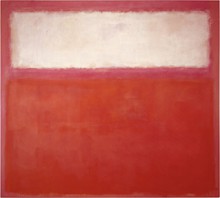Sean Scully
Red Ascending 1990

© Sean Scully. Reproduction of this image, including downloading, is prohibited.
Light, color, density, and darkness make up Sean Scully’s universe of colored panels. His signature colored stripes interlock and weave across the canvas of Red Ascending. There is an earthly density to Scully’s blocks, like the heavy slabs of rock of the ancient dry-stone walls of Aran Island, which Scully photographed in his native Ireland. The ascension from earth to sky informs Scully’s work, even physically as the eye travels up to the top of the red channel in Red Ascending.







